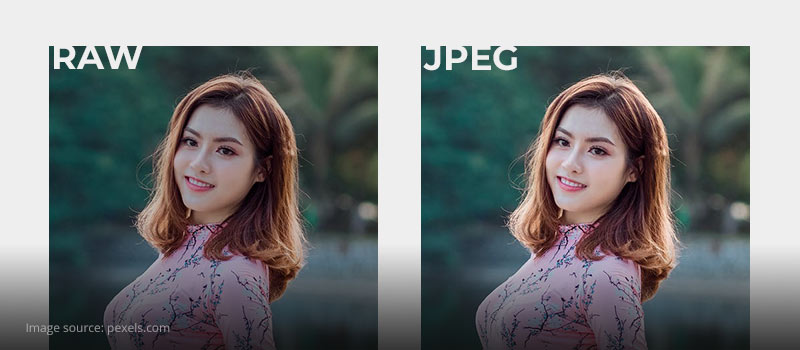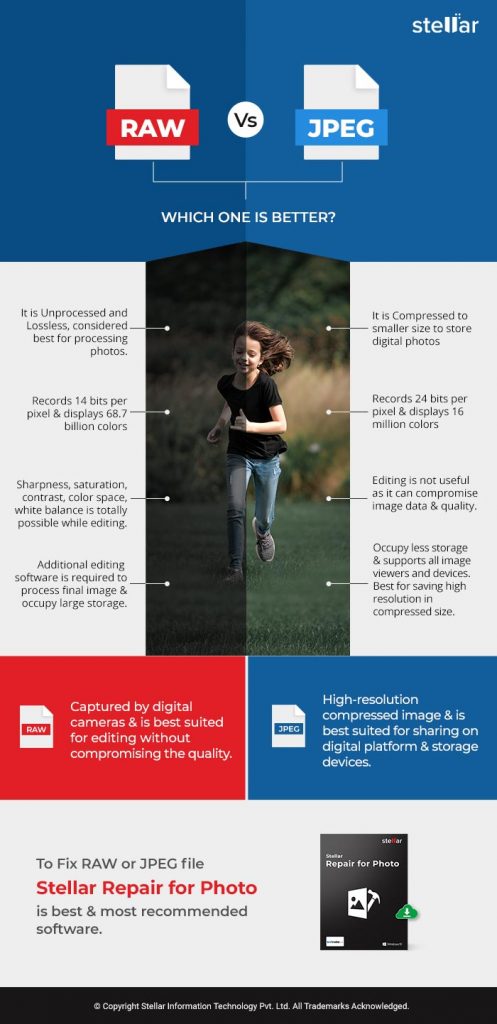The dilemma of shooting in RAW vs. JPEG is not new. Especially those new to photography often ask which format they should choose on their camera LCD screen to capture superior quality pictures.
Professionals may claim uncompressed RAW is the best format, while many others hail JPEG as the most versatile image file.
This post explains how RAW files differ from JPEG, along with the advantages and shortcomings of each. Skipping the technical deep dive, here you will know why the choice of image format in photography should be need-based.
A RAW file is unprocessed and lossless. It has raw image data directly captured from the camera sensor and has maximum image information.
An image shot in RAW format has a wide color palette. It can record 14 bits per pixel and display up to 68.7 billion colors. Thus, RAW is considered the best format for processing photos.
RAW image formats are proprietary to every camera brand. For instance, Canon records RAW images in CR3 & CR2 formats, Nikon does in NEF, Fuji DSLR in RAF, Kodak in KDC, K2F, and so on.
However, not all image-viewing and editing software support RAW formats.
Advantages of RAW format
- Creative flexibility: RAW format offers greater creative liberty while editing. Without worrying about quality loss, you can increase or reduce exposure, sharpness, saturation, contrast, color space, white balance, etc.
- Maintains image quality after processing: Unlike JPEG, lossless compressiondoesn’t degrade the quality of a RAW image file after editing or processing.
Disadvantages of the RAW format
- Need extensive editing: Unprocessed RAW photos usually appear dark and shady. They must be processed and worked upon in an image editing software like Lightroom, Photoshop, etc.
- Occupy more space: RAW files are large and thus occupy greater space in the storage media.
- Not for social media: Large-sized RAW file formats – CR3, NEF, DNG, ORF, PEF, ERF, MRW, NRW, RAF, RW2, SR2, etc., are hard to share and view on the web and social media.
- Take time to transfer or copy: Bigger size RAW files take longer to transfer or copy from camera SD card to computer or other devices.
- Lack of wide software support: RAW formats are unique to camera brands. Camera manufacturers regularly develop new RAW formats, whereas software developers are not always attuned to the launch. So not many image viewing and editing software offer support for RAW camera formats.
When to use the RAW format:
- Editing for professional use: Use pictures shot in RAW format when you want to edit without compromising the quality.
TIP: Repair corrupt or damaged RAW photos
Losing RAW photos to corruption can be terrible, as not many repair software support this unique camera format. Here’s an advanced tool – Stellar Repair for Photo that works on RAW files of Canon, Nikon, Sony, Samsung, Fuji, and several other camera brands. Using the software, you can repair corrupt, distorted, damaged, greyed-out, or inaccessible RAW camera files and JPEG file format from any camera.
JPEG (Joint Photographic Experts Group) image format uses a lossy compression to store digital photos. The file format can store 24 bits per pixel and display over 16 million colors.
Given its ability to compress, it is a popularly used image format. JPEG compresses the image to a smaller size. This helps to increase the number of photos stored in a memory card. You can also share small JPEG files freely on social media and between devices. JPEG can store high-resolution photos in a smaller size as well.
However, the compression in JPEG comes at the cost of the quality of the image. But often, the loss is not perceptible to the eye.
Advantages of JPEG/ JPG format
- Already processed by the camera: When you shoot and save photos in JPEG, the camera has already processed it. Unlike RAW, a JPEG image doesn’t require much work during the processing stage, like setting exposure, white balance, contrast, saturation, sharpening, etc.
- Occupies less space: JPEG is smaller in size than RAW photos, thus occupying less space on the storage media. So prefer JPEG to save unlimited photos on your drive, SD card, USB flash drives, etc.
- Widely supported: All image viewers, editing programs, and devices support JPEG file types.
- Quality after compression: JPEG can save high-resolution pictures in compressed size to an acceptable visual quality.
Disadvantages of JPEG format:
- Irreversible processing: As the camera has already processed the JPEG image, reducing the sharpness, contrast, brightness, etc., is not possible.
- Subsequent work degrades quality: Editing JPEG or any kind of processing can lead to further loss in the image data and subsequently in the image quality.
When to use JPEG?
- Online sharing: Use JPEG to upload pictures on the website or share on Facebook, Instagram, Reddit, Tumblr, WhatsApp, etc.
- Printing: Printing posters, cards, and other high-resolution images.
- Email: Sharing JPEG on email is fast and easy.
- Transfer: JPEG images download, copy, and transfer quickly compared to RAW files.
- Storing more number of photos: Storing digital photos on your computer, SD card, etc.
Shooting in JPEG vs. RAW — which is better?
 Photos captured in RAW and JPEG format
Photos captured in RAW and JPEG format To begin with, ignore the myth that shooting in RAW is always the best choice.
The decision to shoot in RAW or JPEG format should depend on how you will use your prospective images. Be clear if you want to work heavily on your photos, print them, share them on social media, upload them on the web, etc.
Professional photographers usually prefer unprocessed RAW format as it gives them a free hand while editing. But in case you have to quickly share your work with a client or share on social media, capture photos in JPEG format, as the camera already processes them. You can simply download and share them.
If you are a photo enthusiast on a photography day-out and want to shoot more pictures quickly, go for JPEG. The compressed JPG images record faster and occupy less space on the camera SD card. This way, you can save more photos on a single memory card.
So the choice of shooting in RAW vs. JPEG is purely need-based.
PHOTOGRAPHY TIP: To enjoy the best of both JPEG and RAW — shoot in RAW. Once you obtain the high-quality post-processing output of RAW photos, export in JPEG or convert the copy of the RAW to JPEG format for printing or sharing, etc.

To Sum Up – Key differences between RAW and JPEG image files
Image quality – RAW vs. JPEG
The uncompressed RAW files of cameras display higher quality compared with JPEG. Since RAW format captures and stores a lot information through camera sensors, it carries a greater color spectrum and dynamic range. Even with an under or overexposed RAW file, you won’t experience quality loss. Meanwhile, an improper exposure can make a JPEG file grainy, blurry, or pixelated.
File size – RAW vs. JPEG
Since compression reduces the file size, JPEG files are smaller than uncompressed RAW image files. A RAW file can be up to 6 times bigger than a JPEG file. Hence, JPEG occupies less space compared to RAW formats.
Editing – RAW vs. JPEG image
Unlike a JPEG file that is already compressed and processed by the camera, a RAW image file requires quite a lot of work before it can be used. You need to work on color details, contrast, shadows, tones, exposure, etc., of a RAW file to get the best result.
Software compatibility
You can use any photo editor to edit and view JPEG files, such as, PaintShop Pro, Gimp, Pixlr, Photoshop, Elements, etc. However, not every photo editing program or image viewer supports RAW file formats. Other than Adobe’s Photoshop and Lightroom, you can use Luminar AI, Aurora HDR, ACDSee Photo Studio, or AfterShot Pro for editing RAW files.
Sharing – RAW & JPEG
Sharing RAW files is not easy. A large file size of RAW format is often difficult to open or share, as not all image-viewing programs support them. Hence, clients prefer JPEG to preview the pictures. Even multiple JPEG files are easy to transfer via SD card or USB. You can share them through email, chats, messages, or social media platforms.
Speed
JPEGs are faster to edit, share, and open. You can quickly transfer JPEG files across DSLR, Android, iPhone, memory card, etc. However, RAW files take a considerably longer time to copy, open, or transfer.
A camera shooting in RAW too often slows down. To understand, here’s an example. If you own a Canon EOS DSLR, it can shoot over 300 JPEG pictures at 12 fps, whereas in RAW format, it can capture about 200 pictures at the same frame rate. Nonetheless, to avoid slow downloads or transfers, you can convert a RAW file to JPEG, JPG, PNG, or any other format before sharing.
Final words & FAQ
The bottom line is that there’s an image quality difference between RAW and JPEG formats. The uncompressed RAW file displays higher quality. The RAW format makes processing flexible compared to JPEG. Nonetheless, the advantages of keeping to JPEG cannot be ignored, which makes the format highly popular.
So finally, which is better – RAW or JPEG, depends on how you want to utilize the pictures.
Why my RAW photos imported from camera get auto-converted to JPG on MacBook?
RAW images imported from a camera may convert to JPEG because of the settings on your Mac. You might have disabled the ‘Download Originals to this Mac’ option in Photos app or have turned on ‘Optimise Mac Storage’ in Photos, due to which Mac keeps the smaller JPEG files. Also, if you have shot pictures using RAW+JPEG option in camera, then too, the images are imported in the JPEG format. Learn how to fix photo imports being auto converted from RAW to JPG.
Should I always shoot in RAW? Do professional photographers use RAW or JPEG?
You may not always require to shoot in RAW. Photographers prefer RAW over JPEG as it gives them latitude to edit. However, beginners may like to shoot in JPEG, as it requires minimal post-processing. Plus, the smaller JPEG files are easier to share across devices and platforms. So select the photo format as per your need.
Was this article helpful?